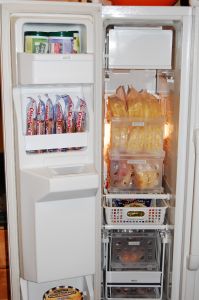Professional Organizer Kelly Pratt from Spaces Limited Organizing shares ideas and helpful tips on ways to organize your freezer.
Establish Clear Categories and Zones
Begin reclaiming your freezer space by clearing out and categorizing. Getting like items together will help you see what you have and make finding what you need a snap. You might have categories for—
• Meats
• Fruits and veggies
• Juices
• Frozen entrees and leftovers
• Ice cream and desserts
• Breads and flours
• Misc. (extra pesto, tomato paste, etc.)
After you have your freezer items categorized, determine their best storage locations within your freezer. Here are a few tips for the best placement:
• Store meats in the coldest part of the freezer, usually toward the bottom or at the back.
• Store small items closer to eye level so they don’t get lost.
• Store items that can be less cold in the door (ice cream, juice, butter, flours, etc.)
Use Internal Containing
If you’ve done organizing projects, you know how using containers can help save you time and money by keeping like items together within your zones. Using this tool also applies to areas of your fridge and freezer. When you select containers for your freezer—
• Opt for clear containers or others you can easily see into.
• Use heavy duty containers that are freezer-safe or freezer-specific, unless you don’t mind replacing plastic containers if they shatter. Remember, containers don’t need to be fancy; you can use large Ziploc freezer bags. Just remember to choose containers that can be easily labeled.
• Look for straight-sided containers with an airtight seal. These will help you maximize space.
• Double-wrap items like meats to prevent freezer burn.
• Use large Ziploc freezer bags to contain bulk items you’ve broken out into smaller portions. For example, rather than storing individual baggies of pre-portioned tomato paste in the door of the fridge, put all the small baggies into one larger Ziploc and store them together.
• Use tiered shelves (like the white plastic-coated wire shelves at Wal-Mart and Target) for casserole dishes, pizzas, etc.
• Pre-portion items bought in bulk so you can more easily contain and store them.
•Date your containers either with the date when you bought the item or with a “use by” date, whichever is more intuitive for you.
Label!
Labeling your containers will help keep your freezer from becoming a final resting place for hundreds of dollars of food by keeping your established zones in place. Because of a freezer’s extreme temperature, choose labels that can take the cold. You can use luggage tags, self-made laminated tags or heavy duty labeling tape.
Create a Master List or Inventory
You can use this concept in one of two ways: you can either inventory everything that is currently in your freezer and make a note of when you use an item from the freezer, or you can keep a running list of items you need to purchase. A small dry erase board or even a piece of paper stuck to the fridge is an effective tracking method.
Consider a Deep Freeze
If your freezer is consistently packed to the gills and beyond, consider a chest or upright freezer.
Chest Freezers
Chest freezers are generally less expensive and have superior cooling capacity (foods will stay frozen during a power outage for 2 to 3 days if the lid remains closed). You can also store large, odd-sized items in a chest freezer more easily. The downside to chest freezers is accessibility. While newer models come equipped with at least one basket for smaller items, it’s easy for things to get lost in a chest freezer without some really good containing in place.
The best containers for chest freezers are those that enable you to lift items out in whole categories. Consider containers like—
• Milk crates.
• Plastic grocery bags.
• Cardboard boxes.
Upright Freezers
Upright freezers are a little more expensive and can have a bit less storage capacity, but if you want an easier go at accessibility and maintaining your organization, an upright is your best choice.
If you just can’t decide and you have the space, you may opt for one of each type of freezer: a chest for meats and specialty baking items (like flours) and an upright for more everyday items.
Happy organizing!
For more information on getting organized go to:
www.spaceslimitedorganizing.com
Email: Kelly Pratt at: kelly@spaceslimitedorganizing.com















Add comment